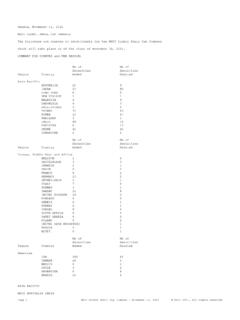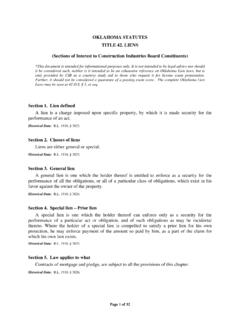Transcription of PROPERTIES OF MILK IMPORTANT CONSTITUENTS OF MILK
1 OUAT- College of Agricultural Engineering and Technology Dept. of Agricultural Processing and Food Engineering Course : Dairy and Food Engineering Chapter 2 PROPERTIES OF milk ( IMPORTANT CONSTITUENTS of milk , IMPORTANT PROPERTIES of milk , Why these PROPERTIES are IMPORTANT for us, Selection of metals for dairy industry) IMPORTANT CONSTITUENTS OF milk The different CONSTITUENTS of milk can be shown as in Fig. Fig. CONSTITUENTS of milk milk contains all essential amino acids in fairly large quantities. It is an excellent source of Ca and P, both of which together with vit D are essential for bone formation. It is a good source of vit A (provided the cow is given sufficient green feed and fodder), vit D (provided the cow is exposed to enough sunlight), thiamine, riboflavin, etc. But milk is deficient in vit C. milk fat, besides giving energy contains significant amount of essential fatty acids (linoleic and arachidonic), which give the characteristic flavor.
2 Lactose (carbohydrate) provides energy. It also helps to establish a mild acidic reaction in the intestine (which checks the growth of proteolytic bacteria and facilitates assimilation). 2 The composition of milk varies with many factors, the most IMPORTANT of them being the species and breed of the animal. Table gives an idea of the variations in major CONSTITUENTS of milk . Table Variation in major CONSTITUENTS of different milk Source of milk Water Fat Protein Lactose Ash Buffalo Camel Cow (Indian) Cow (Foreign) Goat Human Skim milk Butter milk Factors affecting composition of milk Species Breed: In general breeds giving more amount of milk yield a lower percentage of fat. Individuality Interval of milking (Longer interval implies more milk with a lower fat test). Completeness of milking: If the cow is completely milked the test is normal, or else, the test is lower.
3 Irregularity of milking Disease and abnormal conditions Portion of milking: Fore- milk is low in fat content (less than 1%), while strippings are the highest close to 10%. Other milk CONSTITUENTS are slightly affected on a fat free basis. Stage of lactation: The change from colostrum to milk takes place within few days. Yield: For a single cow, there is a tendency for increased yields to be accompanied by a lower fat percentage and vice versa. Feeding: Has temporary effects. Season: The percentage of both fat and solids-not-fat (SNF) show slight but well defined variations during the course of year. Age: The fat per cent in milk declines slightly as the cow grows older. 3 Condition of cow at calving: A cow would yield milk with higher fat per cent if it is healthy. Excitement Administration of drugs and hormones There may also be variations in composition of milk obtained from a specific animal in day to day milking.
4 Energy values of different milk CONSTITUENTS As mentioned above, the milk is a rich source of energy. The energy values of different milk CONSTITUENTS are as follows. milk fat : Cal/g, milk protein : Cal/g, milk sugar : Cal/g Thus, with the available CONSTITUENTS , 100 g of cow milk usually gives 75 Cal and that of buffalo milk gives 100 Cal. What is colostrum During approximately the first three days of lactation, the buffalo/ cow secretes colostrum. This is very vital for the newborn calf and its composition reflects the calf s need. Colostrum contains the IMPORTANT proteins; the immuno-globulins, which are the newborn calf s source of antibodies. The content of iron and copper is markedly higher in the colostrum as compared to normal milk . The average composition of colostrum is as follows. Water: 73% Fat: Total Protein: Lactose: Vitamin A: g/kg Changes of milk due to boiling When the milk is boiled there are several changes in it due to the presence of different CONSTITUENTS .
5 These changes are mainly in the following form. Decrease in the percentage of cream Decrease in curd tension Decomposition of proteins Destruction of enzymes Darkening of the color of milk Coagulation of albumin and formation of a scum on the surface Acquiring a cooked taste Precipitation of Ca and Mg salts 4 Breaking up of fat globules There may be stone formation in milk during heating. Stone formation in milk If the milk being processed has had no previous heat treatment, there are two types of deposits on the heat exchanger/ container surface. This is known as stone formation in milk or fouling. 1. Fouling at low temperatures The soft, voluminous, curd-like material, which starts to form when the temperature exceeds about 75 C. It is at its maximum in the temperature range 95-110 C, and then reduces in amount at higher temperature. This type of deposit restricts the flow passages area and causes increase in the operating pressure.
6 It has high protein content (50-70%), and a lower mineral content (30-40%). at high temperatures Deposits formed at higher temperatures Increases in quantity up to the highest temperature reached in the heat exchanger. Hard and granular in structure containing mineral (70-80%) and protein (10-20%). This deposit interferes more with heat transfer than with flow, and hence to reach the required processing temperature, the temperature of the heating medium has to be increased to an undesirable extent. Both types (1 & 2) of deposit contain negligible amount of fat (about 5%), and protein and minerals are the main CONSTITUENTS . The amount of fouling depends greatly on the pH of raw milk . As the pH falls below about , a large amount of deposit is formed. milk with high contents of -casein are more prone to deposit formation. but the addition of pyrophosphates to milk brings about a significant improvement.
7 IMPORTANT PROPERTIES OF milk The knowledge of different PROPERTIES of milk and milk products are required to design the processing and storage structures for milk . The IMPORTANT PROPERTIES are discussed below. Density and specific gravity The knowledge of density is IMPORTANT to monitor changes during processing check adulteration separate the different CONSTITUENTS of milk (by methods such as centrifugation, cyclone separation, etc.) 5 transport liquid milk as well as processed milk products (by different methods as pneumatic/ hydraulic transportation, etc.) design and develop storage structures for milk and milk products The density and specific gravity of milk is usually given at C (60 F). (The specific gravity of water is usually expressed at 4 C). The specific gravity of some major milk CONSTITUENTS are: water: ; fat: , protein: , lactose: , salts: , and SNF: As we have already discussed that the milks obtained from different animals vary in composition, the densities will also vary.
8 The density of milk of different animals are given below. Cow milk : Buffalo milk : Skim milk : milk powder (bulk density) : ( milk powder has a porosity of 43-51%) Though the buffalo milk contains higher fat, still due to higher SNF, the specific gravity is more than cow milk . Determination of specific gravity of milk by Lactometer Fig. A lactometer immersed in a cylinder A lactometer (or galactometer) is a hydrometer used to test milk . The specific gravity of milk does not give a conclusive indication of its composition since milk contains a variety of substances that are either heavier or lighter than water. Additional tests for fat content are necessary to determine overall composition. 6 The specific gravity of milk should not be determined for at least one hour after it is drawn from the animal, or else, a lower than normal value will be obtained.
9 Quevenne is an arbitrary scale used with hydrometers or lactometers in the determination of the specific gravity of milk . degrees Quevenne = 1000 (specific gravity - 1). The specific gravity of milk is calculated by dividing the Quevenne s degree by 1,000 and adding 1. if the Quevenne reading is 31, then specific gravity = (31/1000)+1= Correction for temperature The lactometers are normally standardized at a particular temperature (say (60 F or C). If the temperature is above or below the standard temperature of 60 F, the lactometer reading should be corrected by adding to the lactometer reading or to the specific gravity for each F above 60 F and vice versa for lower temperatures. Example: If the meter reading becomes at 66oF, what is the specific gravity of milk ? Solution: The corrected lactometer reading is + or Specific gravity: 1+ = In another method, the instrument is graduated into a hundred parts.)
10 milk is poured in and allowed to stand until cream has formed. The depth of the cream deposit in degrees determines the quality of the milk . Another instrument, invented by Doeffel, is two inches long, divided into 40 parts, beginning at the point to which it sinks when placed in water. Some other types of hydrometers Alcoholometer : to measure alcoholic strength of liquids Saccharometer : to measure amount of sugar in a solution Thermohydrometer : that has a thermometer enclosed in the float section Barkometer : to measure strength of tanning liquors used in tanning leather Battery hydrometer : charge of a lead-acid battery can be estimated from the density of the sulfuric acid solution used as electrolyte. Antifreeze tester : to test the quality of the antifreeze solution used for engine cooling. Total solids and total SNF The total solids and solids not fat (SNF) are determined as follows (The method is known as Gerber method).









